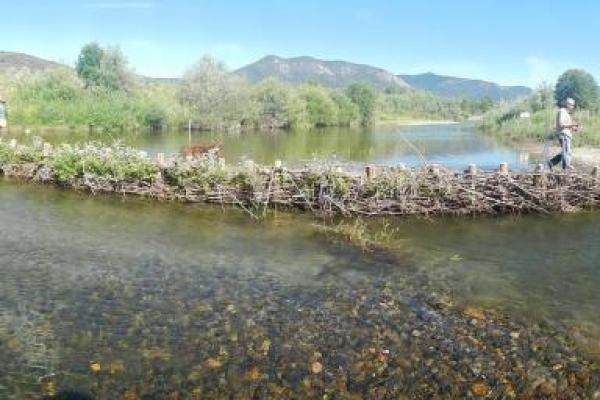Reconnecting with Resilience
April 19 - 22, 2022
Low-tech Process-based Restoration with Beaver and Wood: Jump-starting Structurally Starved Streams Workshop
20 April 2022
9:00am - 5:00pm
A PDF of the Workshop is available here.
A Video of the Workshop is available here.
Workshop Coordinators: Eli Asarian, Riverbend Sciences; Kate Lundquist, Occidental Arts & Ecology Center; Chris Jordan, NOAA, NMFS, and Northwest Fisheries Science Center
The scale and severity of river impairment globally cannot be meaningfully addressed solely using traditional hard-engineering restoration approaches. This workshop will be an opportunity to share recent developments in the evolving science and practice of low-tech process-based restoration (LTPBR) of riverscapes. LTPBR is the practice of adding low unit-cost wood and beaver dams to riverscapes to mimic functions and initiate specific processes that improve river habitats. This workshop will provide an introduction to the LTPBR restoration approach and case-study examples from recent and ongoing LTPBR projects from the Western U.S. including California, Utah, Nevada, Oregon, and Washington. Presentation topics will include:
-
Overview/introduction to the LTPBR restoration approach
-
Effects of LTPBR on geomorphology, hydrology, hydraulics, habitat, water quality, salmonids and other organisms, and ecosystem drought and fire resiliency
-
Updated case studies from restoration projects using beavers and wood
-
Models and tools for prioritizing LTPBR site selection and evaluating outcomes
-
Restoration construction techniques and implementation lessons learned
-
Pathways for permitting LTPBR projects and restoring beavers in California
Presentations will be interspersed with panel/group discussions.
Introduction to Low-Tech Process-based Restoration of Riverscapes Design Principles, Chris Jordan, PhD, NOAA, NMFS, and Northwest Fisheries Science Center
Structural Starvation: Design Examples of Low-Tech Process-based Restoration Across a Diversity of Riverscape Forms, Nick Bouwes, PhD, Utah State University
Structural Starvation: Design Examples of Low-Tech Process-based Restoration Across a Diversity of Riverscape Forms, Nick Bouwes, PhD, Utah State University
Four Criteria for Process-based Restoration of Streams, Damion Ciotti, U.S. Fish and Wildlife Service
Design Tools and Spatial Analysis to Support Low-Tech Process-Based Restoration of Riverscapes, Nick Bouwes, PhD, Utah State University
Thinking Outside the Floodplain: A LiDAR-based Tool to Assess Stream and Floodplain Connectivity, Adam Cummings, US Forest Service
Using Remote Sensing to Inform Beaver-Based Restoration: How to Get Started with Satellites and GIS Tools, Emily Fairfax, PhD, California State University Channel Islands
California’s First Beaver Dam Analogues (BDAs) – What Have We Learned Since 2014, Charnna Gilmore, Scott River Watershed Council
Use of Process-based Restoration Techniques and Tribal Stewardship in a Coastal Tributary of the Klamath River, Sarah Beesley, MS, Yurok Tribe Fisheries Department
Mimicking Beaver Dam Building and Fencing Cattle to Increase Carbon Sequestration and Raise Groundwater Levels in Childs Meadow, California, Sarah Yarnell, PhD, UC Davis
PBR The Hard Way—Fear, Hype and the Reality of Your First 1000 Structures, Kevin Swift, Swift Water Design
Update on California Department of Fish and Wildlife Efforts to Provide a Guidance Document for the Use of Low-tech Process-based Stream Habitat Restoration, Will Arcand, PG, CEG, California Department of Fish and Wildlife
Launch of New California Process-based Restoration Network, Karen Pope, PhD, US Forest Service
Bring Back the Beaver Campaign Updates, Kate Lundquist, Occidental Arts & Ecology Center WATER Institute

